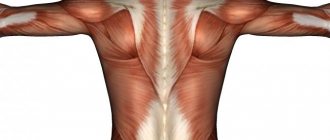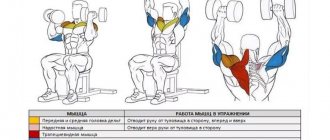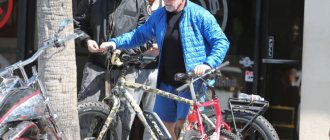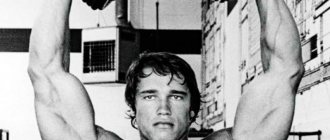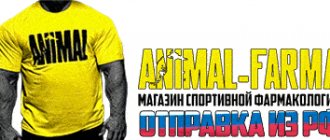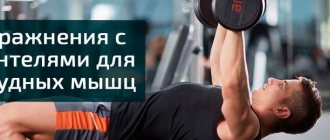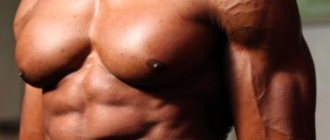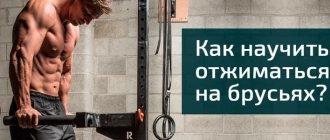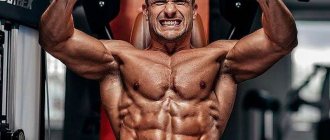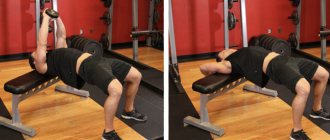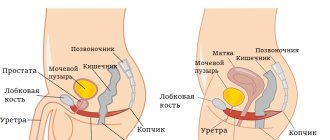Valuable information from the most famous bodybuilder in the world. In this article, Arnold will talk about his training program for all muscle groups. From multi-volume archives, we have collected the most frequently asked questions and topics addressed to Arnold by readers. As a result, we present to your attention a comprehensive seminar by Arnold Schwarzenegger.
Arnold Schwarzenegger's wealth of training knowledge has translated into one of the greatest physiques of all time. In this section, Austrian Oak will answer all your questions regarding training, nutrition and intensity.
Arnold Chest Workout
If you've been unlucky with your genetic breast development or have hit a plateau, there are alternative pressing techniques that can address these issues.
You can resort to presses with a reduced amplitude. When performing full-range presses, at the top of the movement, your triceps are significantly engaged, allowing full extension of the elbow joint.
In this case, the pectoral muscles are involved in the work much less. The trick is to press the barbell to half or 3/4 of its full range of motion without allowing your elbows to fully extend. This technique will allow you to maintain constant tension in the chest without wasting extra energy on blocking the elbow joints.
Dips are one of those exercises that are often neglected when developing the chest, being considered a move reserved for the triceps muscle. To build maximum volume, you definitely need to use additional weights (I used a 36kg dumbbell suspended from a chain from my belt for several sets of 15 reps).
Make sure you use the full range of motion, feeling a good stretch in your pecs at the bottom of the range of motion with each repetition.
In addition, try to keep your body leaning forward and your knees back, without trying to lock your elbow joints at the top of the range.
As for dumbbell flyes, don’t get hung up on using light weights. For some reason, most people believe that flyes must be performed with light weights.
But why? How are you going to add volume using 10kg dumbbells? Choose something heavier.
You'll be pleasantly surprised at how much weight you can actually handle. I usually started with 30 kg dumbbells for the first set of 15 reps, then moved to 35 and 40 kg. while keeping the number of repetitions in the region of 10-15. The key to success is to push yourself even in those exercises that are considered “formative”.
| Exercise | Approaches | Repetitions |
| Bench press | 5 — 7 | 10 — 12 |
| Bench press on an incline bench | 5 | 12 |
| Dumbbell flyes on a horizontal bench | 5 | 10 -15 |
| weighted dips | 4 — 5 | 12 — 15 |
Press
Arnold's stomach was not his strong point. He didn't have a naturally thin waist, nor did he have the deeply etched abs of Frank Zane or Serge Nubret.
But his abs were not a clear weakness either. Perhaps it was because he was a master of deception.
Look at the footage of him posing and you'll notice that he often turned his upper body in such a way that he ended up facing the camera or the judges, regardless of the pose.
This gave him the appearance of a smaller waist and was an important strategy for him in competition.
He also defied any genetic disadvantages by adopting an extremely high-volume training routine consisting of many exercises and high repetitions.
He also admitted that eating right played a major role in reducing the amount of fat around his waist, allowing his abs to become more defined.
That his vacuum posture was not similar to Zane's was not due to a lack of effort or passion. Arnold considered the belly to be one of the most important parts of a man's physique, citing the sculpted bellies of the Greek gods as his inspiration.
“In competition, if you have a little bit of fat on your belly,” he once said, “you can forget about taking home a trophy.”
Training Tips
- Arnold believed that abdominal work should be done every day. He was even known to train it twice a day when he wanted to achieve noticeable results in a short time.
- Arnold's oblique training consisted primarily of controlled twisting movements while holding a barbell on his shoulders. He tried to avoid weighted incline crunches, fearing they would accumulate muscle in that area and make his waist larger.
- He usually trained his abs at the end of his workout, after his calves, another part of the body that he felt needed more frequent training to stimulate their necessary development.
Arnold Abs Workout
- Hanging knee raises – 3 sets of 25-50 reps.
- Raising the body on a Roman chair - 4 sets of 25-30 repetitions.
- Lying leg raises – 3 sets of 25-30 reps
- Side to side twists – 3 sets of 50 reps.
- Hyperextensions – 3 sets of 15 reps.
- Pulling the knees to the chest while sitting – 4 sets of 25-50 repetitions.
Arnold biceps workout
What was the secret to building Arnold Schwarzenegger's legendary biceps peak?
“I've had to discuss the techniques I used to build biceps peaks so many times that the information no longer feels like a secret: supination, turning your wrists outward when lifting dumbbells (with a barbell you physically can't do this movement).
Supination causes the outer head of the biceps to tighten further, thereby increasing the peak and adding additional mass to the area of the arms that is especially visible in the rear double biceps pose. When performing any type of dumbbell lift (standing, sitting, lying down, or concentrated), start with a neutral arm position, and as you perform the lift, rotate your hands so that at the top of the trajectory your palms are facing up.
At the moment of full contraction, rotate your palm so that your index finger is higher than your thumb and further tighten your biceps. The pain from contracting the muscles can be very intense, but it is worth it. Stick to this technique for every rep of all dumbbell curls, and it will make a significant difference in your arm development in the long run.
In addition to supination, I like to have the dumbbell follow the stroke of the wrist to provide a stronger contraction of the biceps. Most people begin biceps exercises with their arms straight and then bend their wrists toward their shoulders as the bar rises.
Thus, part of the force of gravity is neutralized and the essence of the final part of the movement, in which the maximum contraction is created, is lost.
So when I did bicep curls, I allowed the barbell or dumbbells to rest on my fingertips, thereby extending the wrist with each rep rather than bending it or holding it straight, which is what you see most of the time. Thus, at the top point of the amplitude, the weight was not supported by tension in the forearms, but the entire load went into the biceps, allowing them to truly contract.
| Exercise | Approaches | Repetitions |
| Standing barbell curls | 5 | 6 — 8 |
| Alternating standing dumbbell curls | 5 | 8 — 10 |
| Barbell curls on a Scott bench | 4 | 8 — 10 |
| Concentrated curls | 4 | 10 — 12 |
Biceps
Inspired by photographs of his childhood idol Reg Puck in the German magazine Der Muskelbilder, Arnold first visited the gym as a teenager.
He watched gym goers lift weights and did his best to memorize the exercises so he and his friends could do them at home.
Four arm exercises stood out: barbell curls, incline dumbbell bicep curls and Zottman curls for biceps, and close-grip bench press for triceps. At the time, he was most interested in big hands, so that was his starting point.
Surprisingly, when Arnold arrived in America, he had never even seen an isolation curl bench, a device he would soon begin using religiously to build biceps that dwarfed even his predecessors Larry Scott and Sergio Oliva.
He also discovered that American bodybuilders trained more methodically and had a more solid understanding of anatomy and physiology than he did.
Even though he already had the Mr. Universe title and the two biggest hands in the world, he felt he could do better.
“I failed to realize my full potential,” he said many years later. “The deep fibers of my muscles remained intact. It’s like I’ve built a big building on a foundation of sand.”
He recalled watching Scott train and being "particularly fascinated by watching him bomb his biceps on the isolation bench." His arms looked strong and thick after the workout.”
Despite Arnold's incredibly high biceps peak, we can confidently say that it is not a tumor.
Training Tips
- Arnold wasn't afraid to change up his arm exercises, especially standing curls. He felt that working very hard was the best way to gain mass, and if lifting weights required a little cheating, so be it.
- To achieve full biceps development, Arnold always included in his routine at least one exercise (such as dumbbell curls) in which his palm rotated upward (supination) as he lifted the weight.
- Even though the biceps are a relatively small muscle group, Arnold typically trained them at about the same volume as the larger body parts and with the heaviest weights he could handle.
Read also: Strength training in the style of the Tabata protocol.
Arnold Biceps/Forearm Workout
- Barbell curls – 6/7 sets of 6-8 reps.
- Seated dumbbell curls on an incline bench – 6/7 sets of 6-8 reps.
- Curling arms with a barbell on an isolation bench – 6/7 sets of 6-8 repetitions.
- Concentrated dumbbell curls for biceps – 5 rounds of 6-8 repetitions.
- Reverse barbell curls for biceps – 5 sets of 8-10 reps.
- Reverse barbell curl for biceps on an isolation bench – 5 sets of 8-10 repetitions.
- Barbell Wrist Curls – 7 sets of 10 reps.
Arnold Shoulder Workout
“The most effective movement for me was the exercise named after me - the Arnold Press. You actually start this movement from the top point of the dumbbell biceps curl (arms are fully bent at the elbow joint, palms facing you, dumbbells are level with the shoulders).
From this point, you need to press the dumbbells upward, turning them as you lift them with your palms facing away from you, and finish in a position that replicates the classic overhead press. Such a low position of the starting point of the movement trajectory provides a greater amplitude, which has a better effect on the stimulation of the anterior delta bundle.
In addition, I used many other techniques when working on the deltas. For example, when raising dumbbells to the sides, I turned my palms so that my little fingers were higher than my thumbs along the entire trajectory of movement, as if I were pouring water from a jug.
This technique truly isolates the middle bunch of deltas. In addition, when performing lateral raises of dumbbells, I always raised them significantly above parallel with the floor - now rarely anyone does this. Most people raise the weight to parallel, but I always felt a stronger contraction when lifting the dumbbells a little higher.
Of course, like most other athletes, I did drop sets, starting with heavy dumbbells (for example, 22 kg). Having completed the exercise to muscle failure, I took dumbbells 2 kg lighter, again reached failure, and so on, in 2 kg increments I reached dumbbells of 5 or 7 kg. I used this approach in order to achieve a burning sensation in the muscles, add quality and the necessary separation.
From time to time I would do a triset of dumbbell lateral raises, heavy barbell overhead presses, and barbell chin rows. All three exercises were performed without rest in between: first I did the press, then the rows and finally the lateral raises. Probably my favorite technique when performing lateral raises was isometric contractions.
| Exercise | Approaches | Repetitions |
| Arnold press | 5 | 8 — 10 |
| Triset barbell overhead press, barbell row to the chin, dumbbell lateral raises | 5 | 6 — 8 |
| Dumbbell lateral raises (drop set) | 1 | 50 |
What muscles work?
The main work is performed by the anterior and middle bundles of deltoid muscles. The triceps are also involved in the movement. A small part of the load is taken by the supraspinatus and infraspinatus muscles.
If you perform a standing Arnold press, an axial load is created on many stabilizer muscles, including the spinal extensors, hamstrings, abdominal muscles and trapezius muscles.
Arnold's leg workout
To add significant value to your legs, you need to shock them - this is the key to success. The most obvious solution is to perform lots of very heavy sets of compound movements: barbell squats, leg presses, and hack squats. Since the legs are a massive muscle group, you will have to train them to a much greater extent than other, smaller muscle groups.
Often, I would do more than 20 sets for the quadriceps alone and only then move on to working the hamstrings. High-volume, high-intensity workouts will shock your legs and make them grow, but adding detail to your legs is just as important.
Why do you need big hips without relief and shape? This is why I used techniques like drop sets during hack squats. I loaded the machine with a weight that would only allow me to do about six reps. Then I would drop the weight a little and do six more. So I would drop the weight and perform the exercise without rest until I had about 30 reps. And this is just one approach! I also used the same technique when doing hip extensions.
But my most significant breakthrough in leg development came in 1971, when I was looking for methods to add more detail to the legs. I started the workout by doing leg extensions followed by barbell squats. This method is now called pre-exhaustion.
When doing kips, I did very heavy sets and went all out on them, instead of using this exercise only as a warm-up and prep for squats. By the time I moved on to squats, my quads were already dead.
| Exercise | Approaches | Repetitions |
| Superset leg extensions with barbell squats | 5 — 6 | 15 — 20 |
| Leg presses | 5 | 15 |
| Squats on a hack machine | 4 | 30 |
Legs
In the early days, Arnold's leg training protocol suffered from two critical flaws: lack of use and, as Joe Weider called it, primitivism. The first was quite simple: the young Austrian did not train his legs at all in his first year of bodybuilding.
Having finally grasped the needs of lower body training, he went beyond that, even going so far as to train his legs every day for a year with 10 sets of squats and 10 sets of leg curls. Not surprisingly, he was not satisfied with the results.
His "primitive" methods were most evident in the climbing "retreats" he and his buddies made in the Austrian countryside.
They loaded several cars with cargo (and girls) and drove off to a remote area among the trees where they could train. They squatted from morning until noon, rested, had fun, drank beer, and then returned to squats again.
When Vader appeared, outdated training methods went by the wayside, as did drinking beer. He felt Arnold's legs become bulky and fuzzy.
“Your legs are suffering compared to your upper body, and you desperately need to completely change your leg training program,” Weider told young Arnold. "I also think others may have noticed this strange effect and been puzzled by it."
Read also: Training program for women: the principle of supersets.
Arnold agreed. The result of this rethink was the type of training you see here, not to mention the proportionate legs that helped him win seven Mr. Olympia titles.
Training Tips
- Arnold often divided his quadriceps workouts into two sessions, performing the first three hip exercises in the morning and the last one or two in the evening. This ensured that each exercise was performed at maximum intensity.
- Despite the intensity of his leg training, Arnold usually took short breaks between sets - no more than one minute. This created a “filling” effect, keeping maximum blood in the muscles throughout the session.
- Sometimes he would do leg curls mid-workout (after squats and before leg presses) to give the front of his thighs a little break. Then at the end of the workout he would do more sets of hamstrings.
Arnold's leg workout
- Back squats – 5 sets of 8 reps.
- Front squats with a barbell – 5 sets of 8-10 reps.
- Leg press – 5 sets of 10 reps.
- Leg extensions – 5 sets of 10 reps.
- Lying leg curls – 8 sets of 10 reps.
Arnold's calf workout
When I first came to America in 1968, I did not have large calf muscles. In 1969 I visited Reg Park at his home in South Africa and stayed with him for a while. Per often woke up at 5 a.m. to train. Since he was my idol during those years, I also had to get up at 5 am. The first thing he started any workout with was 10 sets of calf raises. His calves were huge, about 50 cm in circumference. I remember looking at them and saying, “I want a drumstick like that.” He loaded the machine with 220 kg and began his first approach.
I screamed: “220 kg! I’ll tear off my Achilles tendons!” To this Per answered me: “During normal walking, when one of your legs takes a step, the other one carries 112 kg. respectively, both legs are able to withstand 220 kg. But to really make your calves grow, you need to get to a working weight of 450kg.” I screamed: “It can’t be!” In the first year, my lower leg grew by 5 cm. It grew so quickly that some people began to suspect me of using implants.
They started checking me, looking for signs of scars when I tensed my muscles. I took this kind of attention as a compliment - my calves have increased to 52 cm. The main exercises I use should not surprise you in any way: “donkeys”, standing and sitting calf raises in the machine, as well as in the leg press machine. Each of these exercises in 6 sets of 10-20 repetitions.
But much more important, in addition to the number of repetitions and sets, is the style of exercise. To achieve maximum development in your calves, you need to use the full range of motion on each rep.
This means achieving full stretch at the bottom of the amplitude and maximum contraction at the top. Again, it's all about systematic progress. If you're using a 1,000-pound weight but can't perform the full range of reps, you're just wasting your time. Your goal is to use as much weight as possible while performing the exercise through the full range of motion. In addition, I used all possible techniques in order to develop maximum intensity and stimulate muscle growth.
Besides forced reps with the help of a training partner, my favorite techniques were peak contractions and what I called the “pump action.” The principle of peak contraction is extremely simple and its essence is to hold the weight at the top point of the amplitude for 3-4 seconds before lowering it.
It's always painful, but I was conditioning myself that the pain and burning would make me bigger. The pumping action was used at the end of an approach, for example, seated calf raises or a leg press machine. After I could no longer complete full range reps, I would finish set 6 with a series of reduced range reps (without dropping my heel all the way down or lifting it all the way up) until my calves began to cry out in pain. This technique sculpted the outer shape of my lower leg into truly champion shape.
| Exercise | Approaches | Repetitions |
| Calf raises (“donkey”) | 5 — 6 | 15 — 20 |
| Standing calf raises | 5 — 6 | 10 — 20 |
| Seated calf raises or leg press machines | 4 -5 | 10 — 15 |
Caviar
Arnold's self-consciousness about his calves has been widely publicized over the years. They used to be small, so he cut off the bottom of his sweatpants while he was working out.
This motivated him to improve the area, which he eventually did, building massive calf and soleus muscles.
Extremely high training volume and frequency were his keys to identifying this weak point. When it came to training his calves, Arnold was a little smarter. Here's what he said in an episode of Muscle Builder:
“Calves are like no other muscle and they seem to be in a different mood every day. Sometimes I can do calf raises with shoes on and it feels better, sometimes my shoes get in the way and I have to do the exercise barefoot... It's weird, kind of weird.
“The secret I've learned is to test the individuality and position of the calves with two or three sets, and then I know which way they want to go that day. They will let you know - just give them a chance to "talk" to you. It's like they have a mind of their own—a brain that other muscles don't have.”
Training Tips
- Arnold loved variety when it came to training his calves. Anything that shocked stubborn muscles was fair game: high reps, low reps, super short rest periods (15-30 seconds), supersets, etc.
- For the most part, his calf exercises pushed them through a full range of motion—down to a full stretch, then up until they were fully contracted. But sometimes he would also do full sets of partial reps, which allowed him to work much harder; or he'd finish full-range-of-motion sets with a few partial exercises to burn off his calves.
- It was not uncommon for Arnold to train calves six days a week in his famous double-split training regimen. The calves were usually worked with the abs in an afternoon workout, either with the quads or on their own.
Arnold's calf workout
- Donkey calf raises - 5 sets of 15-30 reps.
- Standing calf raises – 5 sets of 15-30 reps.
- Toe press in the simulator – 5 sets of 20-30 repetitions.
- Calf raises with dumbbells on one leg while standing – 3 sets of 15-30 repetitions.
Arnold back workout
The key to success for me was the use of not only wide-grip pull-ups (which were almost the only pull-up option for bodybuilders at that time), but also other variations that helped work the back muscles from a variety of angles.
I often performed close-grip pull-ups, occasionally using a straight or reverse grip, or a V-handle attached to a regular pull-up bar. I constantly changed all these variations among themselves in order to surprise my muscles.
In addition to the variability, I always used the full range of motion for each repetition. This may sound basic, but it's surprising how many guys do this exercise at half the range. At first glance, wide-grip pull-ups themselves are not full-range, but I found out for myself that you will get the maximum benefit from this exercise only if you touch the bar with your chest when pulling up in front of you and touch your neck when pulling up behind your head.
The same rule applies to close-grip pull-ups - try to touch the bar with each repetition. Of course, this is not so easy at first, but later you will achieve high repetitions and even reach weighted pull-ups.
Start with vertical rows on the machine. Once you reach a working weight equivalent to your body weight that you can perform about 8 reps with, leave the machine and start doing pull-ups. Let's say. One day, before training your back, you will set yourself to do a total of 50 pull-ups. On your first set, you may be able to do 10 pull-ups. In the second you will have to fight for 8. Now you have 18 repetitions. If you manage to complete 5 reps on the third set, you will already have 23 reps. Continue in this manner until you complete all 50 reps, even if it means doing 20 sets. Over time, you will notice that you will need fewer and fewer sets to complete the same 50 reps.
Once you reach 12 reps in one set of any type of pull-up, you can safely add additional weight to the belt. It is at this point that real muscle growth begins. If you can do 12 reps with your body weight without any problems, then adding 5 kg of weight can throw you back to 10 reps.
In this case, again, you need to work until you can perform 12 repetitions, but with these 5 kg. Then increase the additional weight to 10 kg and continue towards the 12 rep goal. I know people who are able to do pull-ups with an additional weight of 25, 30 or even 35 kg. and they all have incredible lats. If you do pull-ups all the time without additional weights, you will never reach the maximum potential of your back muscles.
| Exercise | Approaches | Repetitions |
| Wide grip pull-ups with additional weights | 4-6 | 10-12 |
| Deadlift | 4-5 | 6-10 |
| T-bar row | 5 | 10-15 |
| Close-grip barbell row to the chin | 5 | 10-15 |
Arnold's triceps workout
The truth that I have learned over many years of training is that isolation exercises are critical to triceps development. Triceps exercises should isolate all three heads of this muscle. Accordingly, you need to know which exercises involve which triceps heads. Early in my career, I adopted Vince Gironda's method of determining which exercises would work most effectively on which areas of the body.
Vince would do the following. He would choose one exercise and perform 15-20 sets of 20 reps with it. And it's all. Nothing more for this muscle group on this day. The next day, based on muscle soreness, he would deduce which part of the triceps this particular exercise worked the most.
If he were to perform lat pulldowns, he would understand whether this exercise better targets the outer or inner triceps, and whether the movement engages the lower portion of the muscle group. Using this method, you can determine for yourself which movement uses which part of the triceps.
You must learn to train based on your instincts. Training triceps is different from training biceps because when training biceps, you essentially have just one movement - a curl - in which you try to use every possible variation (using barbells, dumbbells, Scott bench, etc.).
With the triceps, you have the option of performing the exercise in front of you, overhead, or in a prone position, as well as with a close-grip barbell press. To maximize growth stimulation, the triceps must be extremely isolated in each exercise, so try to concentrate as much as possible during each exercise.
| Exercise | Approaches | Repetitions |
| Close grip barbell press | 4 — 5 | 6 — 8 |
| Arm extensions on the upper block | 4 — 5 | 8 — 10 |
| Overhead dumbbell extensions | 4 — 5 | 10 — 12 |
| Kickbacks with a dumbbell | 4 — 5 | 12 — 15 |
Related video: Arnold Schwarzenegger training:
Shoulders
“A man with broad shoulders feels superior and has a greater sense of security and self-confidence,” Arnold once told a magazine.
Not surprisingly, he scoffed at the large number of bodybuilders he knew whose training regimens lacked any shoulder work.
It's no surprise that the only exercise named after him, the Arnold Press, is a deltoids exercise.
Early in his bodybuilding career, Arnold's deltoids were the weakest part of his upper body.
So he worked tirelessly on them, and after winning the 1967 Mr. Universe competition in London, he attributed the victory largely to his improved shoulder development.
Three years later, in the 1970 Universe, he defeated his idol Reg Park and again wrote that he was grateful for training his shoulders so hard.
Joe Weider once asked Arnold what role he thought bone structure played in shoulder development—in other words, were some people born with more potential than others?
The future governor of California has acknowledged that some people have a genetic advantage (Steve Reeves and Frank Zane among them), but that doesn't mean others, less blessed, can't greatly improve their knowledge in this area.
He claimed that anyone could widen their shoulders by at least 5 centimeters with "direct and specialized training."
Training Tips
- Arnold kept barbell work to a minimum when training his shoulders. He reasoned that all the bench and incline presses he performed, which also hit the delts to some extent, would be enough.
- For a while he trained his delts primarily in workouts that also included arms, explaining that his delts were naturally weak and needed to be worked while they were fresh. It would be hard to find Arnold training his shoulders in the same workout as his chest, as many people do.
- Even though they weren't often mentioned, the trapezius muscles were never ignored in Arnold's training. He often pumped traps after delts in the same workout.
Arnold Shoulder Workout
- Barbell curls and standing presses – 1 set of 20-30 repetitions.
- Arnold Press – 5 sets of 6 reps in a superset with bent over dumbbell lateral raises – 5 sets of 8-10 reps.
- Lying dumbbell lateral raises – 5 sets of 12 reps *
- Lateral abduction of the arm from the lower block - 5 sets of 12 repetitions.
- Alternately lifting dumbbells in front of you - 3 sets of 12 repetitions.
*Lie sideways on an incline bench
